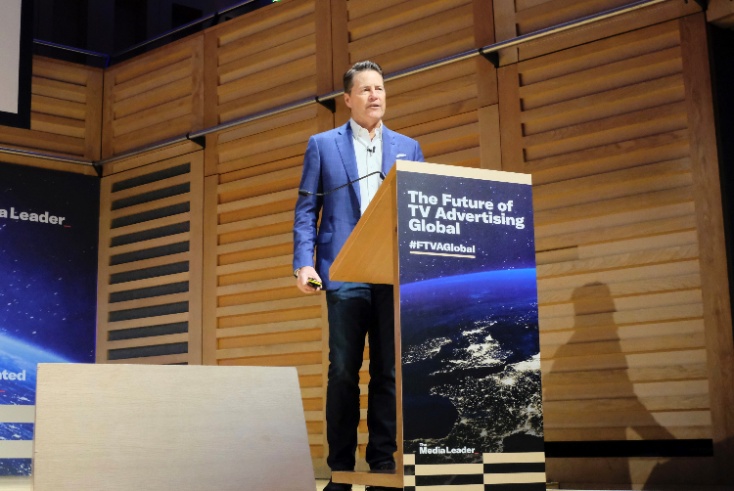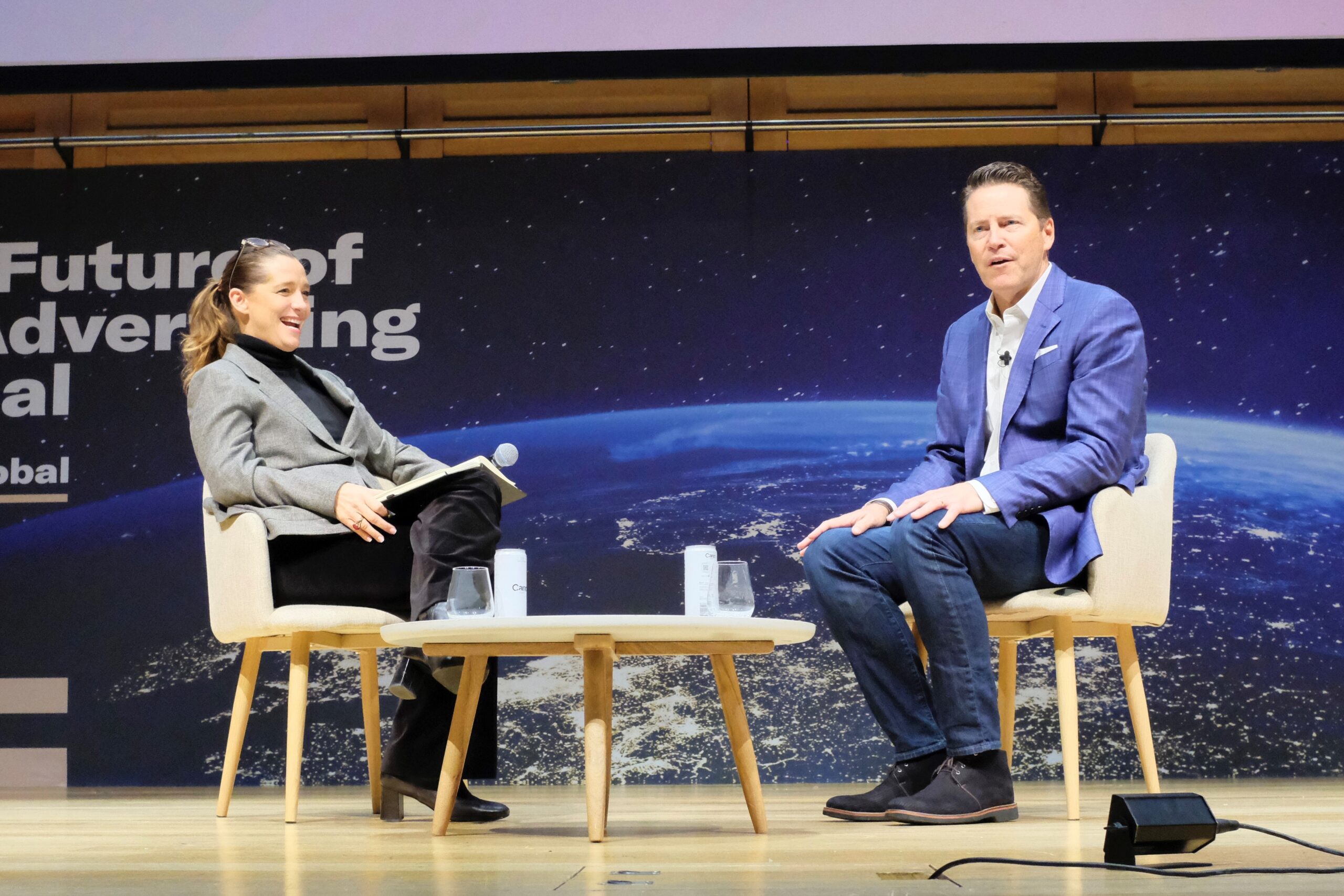Netflix faces ad buyers and pledges to ‘set a new standard’

“Building the business at Netflix over the last year has been an incredible journey. We’ve come a long way in a short time and we’ve done it using the same playbook that’s made Netflix the global leader in streaming.”
This is how Netflix’s VP of advertising, Peter Naylor, kicked off his presentation on the platform’s vision for the future of ad-supported streaming at the Future of TV Advertising Global 2023.
In front of an international TV advertising crowd, Naylor spoke about the streamer’s growing measurement capabilities, new advertising formats, alongside a forward look at moves into live broadcasts and experiences.
He was keen to show advertisers the streaming giant was “not just trying to offer what everyone else is offering” and that it was trying to “set a new standard” and “superior ad models” to drive expectations and results for advertisers.
Naylor also addressed a room of media agency representatives, ad buyers, and other industry stakeholders in a private session. Netflix’s first year of advertising has been widely reported to have faced difficulties, including a renegotiation with its ads delivery partner Microsoft.
Measurement, verification and transparency
The first part of the presentation centred on measurement capabilities, a hot topic for advertisers.
Naylor said: “We consistently hear the need for enhanced measurement and verification. We now offer more options to reach and target your desired audience, more transparency to help measure and prove success, and more opportunities to drive impact.”
DoubleVerify and Integral Ad Science are Netflix’s third-party verification partners globally, and in partnership with Microsoft Advertising AudienceProject have been appointed for audience validation.
Naylor said Netflix would continue to “build and enhance” measurement capabilities across the region.
Ad formats: single titles and bingeing
In addition to measurement and verification, Naylor showcased formats to help advertisers “be culturally relevant” and “connect with audiences”.
The “top 10” format allows advertisers to target media placements across the top 10 most-watched series and films which are updated daily.
Single title sponsorships have been tested initially in the US, with SmartFood being the first brand to get involved with a sponsorship of the latest season of Love is Blind. These were followed by TMobile for Squid Game: The Challenge, and L’Oréal brand Lancôme on the second part of the final season of The Crown.
Naylor said single title sponsorship will be available in the UK in February, and be expanded to all markets in future.
He also spoke about a format designed for binge-watching, which has been spoken about in recent earnings calls.
Naylor said: “Finally marketers understand that viewers have ripped up the old playbook and are watching TV in a new way, the way they want to watch and it’s why you want to go beyond conventional TV spots to reach viewers who are deeply engaged in the content. With that in mind, we’re excited to offer a format that leads into this new viewing behaviour launching next year.”
The format allows ad tier viewers to watch two to three episodes consecutively, and then offers the next episode ad-free “made possible by an advertiser” with a solo spot between episodes.
Naylor explained that more than 80% of ad-supported members watch Netflix for two hours or more, so this format allowed brands “to stand out”.
Netflix was also entering the world of live experiences as it hosted its first live sports event last month with “The Netflix Cup”, a combination of two of its most popular sports hits Drive to Survive and In Full Swing, with T Mobile, Nespresso, American Express and Visit Morocco as official partners.
Naylor called this ” a very fun and new way” for advertisers to get involved and looking ahead said they could not wait to collaborate with clients as “we entertain the world together”.
He added: “All of this is about giving you, the advertiser, more of what you want, so please keep telling us what you want, because we’re going to keep investing, innovating and building something better together.”
Is Netflix ‘a proudly advertising business’?
For the final part of the session, Naylor was joined on stage for a fireside conversation with Nicola Lewis, chief solutions officer at GroupM Nexus (previously CEO of GroupM’s addressable TV-buying arm Finecast).

Lewis said several factors over the last year represented “a pivotal moment within television” with the decline in linear in some markets dipping below 50% (like in the US), growing streaming viewership (to 38.7% in the US) and global subscription forecasts showing subscription video-on-demand (SVOD) would hit $1bn by 2029. This was particularly notable against the backdrop of an economy “driven by change”, the Hollywood actors’ and writers’ strikes, and pressure on content.
Lewis asked about how Naylor felt about ad loads, frequency capping and integration.
He said: “We’re going to be ever vigilant about frequency capping because the viewer experience is everything.
“We always make sure that whatever we do, we make sure that it’s not going to cause viewer harm. We’re making sure that the subscription price for the ad-supported tier, it’s attractive, but then we don’t take advantage of the fact that they’ve opted into ads to overwhelm them with ads or anything.
“We want to make sure that the value is really there for the marketer.”
Netflix bullish about copycats
In terms of integration, he stressed that the Netflix ads department was “always looking for opportunities to bring advertisers in beyond 15-second and conventional spots”.
He cited the example of bringing in advertisers to the newly proposed “Netflix House” destinations for fans, which will have theatres and food experiences, as well as involving other fan platforms like Netflix Tudum.
“There’s all these multi-dimensional ways to get involved. Why not make another show behind-the-scenes podcast? We’re only limited by our creativity right now,” he added.
Lewis also asked Naylor about how Netflix felt it sat competitively with the likes of Amazon Prime Video, Paramount+ and Disney+.
Naylor was bullish, stating that Netflix was in “a good position” and “moving in the right direction” given it had created so much of the streaming paradigm that people look at and “frankly, try to emulate”.
He said Netflix would “continue to win on content” as they create content in 50 countries around the world, more in local markets than ever before.
Naylor added: “We’ve got the content, we will have the audience and with that, we will have the opportunity, so I feel like we’re in a really wonderful position to compete.”
Finally, Lewis asked Naylor if Netflix was “actually proudly an advertising business”.
“Yes, we’re proud to be an ad business,” he said. “It’s a growth initiative for us. Our mission quite simply is to entertain the world. With this new, lower tier of subscription we can entertain more in the world and help marketers achieve their goals.”
Currently Netflix’s ad tier reaches more than 15 million monthly active users across 12 ad-supported countries like the US, UK, France, Germany, Spain and Italy.
At the same conference last year, Netflix’s former president of worldwide advertising Jeremi Gorman had grand visions for the streamer’s advertising offering, saying she wanted it to be a marquee advertising destination that is thought of as highly as Times Square, the Piccadilly Lights, the Super Bowl or the World Cup. That was her first industry appearance since starting in the role that she would leave after just a year.
Netflix ads chief: ‘the way we’ve launched is not where we want to be’
The Media Leader is the publication partner for The Future of Advertising Global — the world’s leading conference for media and advertising professionals and takes place on 5 and 6 December in London.
Tomorrow’s lineup includes advertising effectiveness guru Peter Field, and ITV CEO Carolyn McCall who will speak to The Media Leader‘s editor-in-chief Omar Oakes.




